Localized delivery of therapeutic doxorubicin dose across the canine blood-brain barrier with hyperthermia and temperature sensitive liposomes
- PMID: 29688083
- PMCID: PMC6058514
- DOI: 10.1080/10717544.2018.1461280
Localized delivery of therapeutic doxorubicin dose across the canine blood-brain barrier with hyperthermia and temperature sensitive liposomes
Abstract
Most drugs cannot penetrate the blood-brain barrier (BBB), greatly limiting the use of anti-cancer agents for brain cancer therapy. Temperature sensitive liposomes (TSL) are nanoparticles that rapidly release the contained drug in response to hyperthermia (>40 °C). Since hyperthermia also transiently opens the BBB, we hypothesized that localized hyperthermia can achieve drug delivery across the BBB when combined with TSL. TSL-encapsulated doxorubicin (TSL-Dox) was infused intravenously over 30 min at a dose of 0.94 mg/kg in anesthetized beagles (age ∼17 months). Following, a hyperthermia probe was placed 5-10 mm deep through one of four 3-mm skull burr holes. Hyperthermia was performed randomized for 15 or 30 min, at either 45 or 50 °C. Blood was drawn every 30 min to measure TSL-Dox pharmacokinetics. Nonsurvival studies were performed in four dogs, where brain tissue at the hyperthermia location was extracted following treatment to quantify doxorubicin uptake via high-performance liquid chromatography (HPLC) and to visualize cellular uptake via fluorescence microscopy. Survival studies for 6 weeks were performed in five dogs treated by a single hyperthermia application. Local doxorubicin delivery correlated with hyperthermia duration and ranged from 0.11 to 0.74 μg/g of brain tissue at the hyperthermia locations, with undetectable drug uptake in unheated tissue. Fluorescence microscopy demonstrated doxorubicin delivery across the BBB. Histopathology in Haematoxylin & Eosin (H&E) stained samples demonstrated localized damage near the probe. No animals in the survival group demonstrated significant neurological deficits. This study demonstrates that localized doxorubicin delivery to the brain can be facilitated by TSL-Dox with localized hyperthermia with no significant neurological deficits.
Keywords: Thermosensitive liposomes; blood–brain barrier; doxorubicin; hyperthermia; liposomes; thermal therapy.
Figures


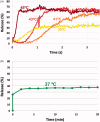
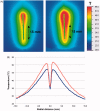
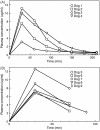


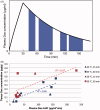
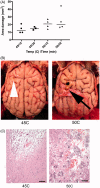
Similar articles
-
Closed-loop trans-skull ultrasound hyperthermia leads to improved drug delivery from thermosensitive drugs and promotes changes in vascular transport dynamics in brain tumors.Theranostics. 2021 May 24;11(15):7276-7293. doi: 10.7150/thno.54630. eCollection 2021. Theranostics. 2021. PMID: 34158850 Free PMC article.
-
Real-time fluorescence imaging for visualization and drug uptake prediction during drug delivery by thermosensitive liposomes.Int J Hyperthermia. 2019;36(1):817-826. doi: 10.1080/02656736.2019.1642521. Int J Hyperthermia. 2019. PMID: 31451077 Free PMC article.
-
Method of hyperthermia and tumor size influence effectiveness of doxorubicin release from thermosensitive liposomes in experimental tumors.J Control Release. 2016 Jan 28;222:47-55. doi: 10.1016/j.jconrel.2015.12.004. Epub 2015 Dec 3. J Control Release. 2016. PMID: 26658073
-
A moderate thermal dose is sufficient for effective free and TSL based thermochemotherapy.Adv Drug Deliv Rev. 2020;163-164:145-156. doi: 10.1016/j.addr.2020.03.006. Epub 2020 Apr 2. Adv Drug Deliv Rev. 2020. PMID: 32247801 Review.
-
Thermosensitive Liposomes for Image-Guided Drug Delivery.Adv Cancer Res. 2018;139:121-146. doi: 10.1016/bs.acr.2018.04.004. Adv Cancer Res. 2018. PMID: 29941102 Review.
Cited by
-
Hyperthermia Treatment Planning Including Convective Flow in Cerebrospinal Fluid for Brain Tumour Hyperthermia Treatment Using a Novel Dedicated Paediatric Brain Applicator.Cancers (Basel). 2019 Aug 15;11(8):1183. doi: 10.3390/cancers11081183. Cancers (Basel). 2019. PMID: 31443246 Free PMC article.
-
Bufalin-Loaded PEGylated Liposomes: Antitumor Efficacy, Acute Toxicity, and Tissue Distribution.Nanoscale Res Lett. 2019 Jul 5;14(1):223. doi: 10.1186/s11671-019-3057-0. Nanoscale Res Lett. 2019. PMID: 31278603 Free PMC article.
-
Emerging Nano-Carrier Strategies for Brain Tumor Drug Delivery and Considerations for Clinical Translation.Pharmaceutics. 2021 Aug 3;13(8):1193. doi: 10.3390/pharmaceutics13081193. Pharmaceutics. 2021. PMID: 34452156 Free PMC article. Review.
-
Intravenous injection of cyclophilin A realizes the transient and reversible opening of barrier of neural vasculature through basigin in endothelial cells.Sci Rep. 2021 Sep 29;11(1):19391. doi: 10.1038/s41598-021-98163-w. Sci Rep. 2021. PMID: 34588482 Free PMC article.
-
In situ vaccination with laser interstitial thermal therapy augments immunotherapy in malignant gliomas.J Neurooncol. 2021 Jan;151(1):85-92. doi: 10.1007/s11060-020-03557-x. Epub 2020 Aug 5. J Neurooncol. 2021. PMID: 32757094 Review.
References
-
- Aoki H, Kakinuma K, Morita K, et al. (2004). Therapeutic efficacy of targeting chemotherapy using local hyperthermia and thermosensitive liposome: evaluation of drug distribution in a rat glioma model. Int J Hyperthermia 20:595–605. - PubMed
-
- Brouckaert P, Takahashi N, van Tiel ST, et al. (2004). Tumor necrosis factor-α augmented tumor response in b16bl6 melanoma-bearing mice treated with stealth liposomal doxorubicin (doxil®) correlates with altered doxil® pharmacokinetics. Int J Cancer 109:442–8. - PubMed
-
- Carpentier A, Canney M, Vignot A, et al. (2016). Clinical trial of blood-brain barrier disruption by pulsed ultrasound. Sci Transl Med 8:343re2. - PubMed
-
- CBTRUS (2017). Central brain tumor registry of the United States. Available at: http://www.cbtrus.org [Last accessed Dec 2017]
MeSH terms
Substances
Grants and funding
LinkOut - more resources
Full Text Sources
Other Literature Sources
Medical
